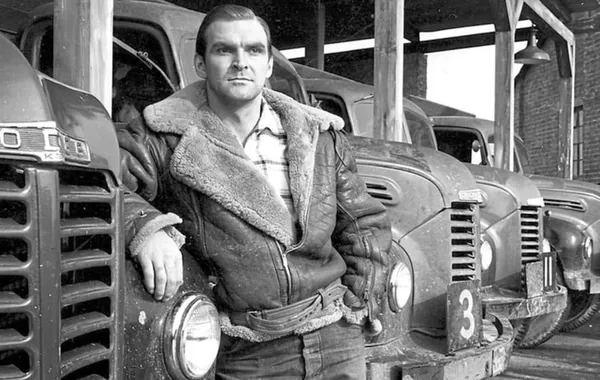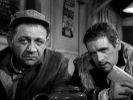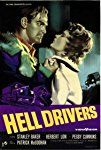Eye For Film >> Movies >> Hell Drivers (1957) Film Review
Hell Drivers
Reviewed by: Andrew Robertson

An ex-con and a bad job - but that's not the beginning. What we start with is a bit of cranked footage, the same trick George Miller used decades later for Mad Max. A truck, a Dodge, both senses, speeding down a road. Its load is ballast, but it's otherwise freighted with import, fated.
It starts with a man, Tom, Stanley Baker in a leading role. An actor of rare qualities, his career cut short by illness, he's one of a a cast that in 1957 showed quality but in retrospect seems almost ludicrous - Baker himself, but also Patrick McGoohan, William Hartnell, Sid James, David McCallum, Sean Connery, all names almost instantly recognisable - the first Bond, the first Doctor Who, Number Six, the first Ilya Kuryakin, Carry On! - and also Jill Ireland, Peggy Cummins, Marjorie Rhodes, actresses whose names may not be recognised but whose faces would be. John Kruse co-wrote the script, his first film as writer, based on a short story, produced by Pinewood Studios where he worked. His later career included scores of television series, including The Avengers and The Saint with another man who would be Bond. Director C Raker Endfield would work with Baker again on Zulu, in a career that includes all sorts of films that look like ones you've heard of.

Hell Drivers is a gem - that cranked footage looks a little dated, even in black and white, but later shots look to integrate what are probably models and fullers earth with real quarries, real drops. It's an incredibly efficient story - tightly wound - Tom at the gates, looking for a job. The firm are Hawlett's, the load is ballast. Dangerous business - "they put a silver plate in his skull", but that's not the only danger. That man "couldn't handle the loads, not at the speed we want", but more dangerous than the roads at fifty miles an hour is possibly Mr Cartley's contempt.
There's rivalry - Tom ends up driver 13, but number one, 'Red', is McGoohan, anger and bristle and bully, enough of all of that for four men - foreman, ostensibly, but he's an enforcer. In an early shot there's a bulldozer, from a "dose of the bull(whip)" - slave-driving, and this isn't far short.
The job is simple enough - ballast from quarry to site, twelve loads a day, minimum - but this is dangerous stuff. Efficiences include sustenance on the road-way - Tom has an apple - Red a bottle of Guinness, the harp-bearing bottle opened on the spokes of the big wheel. Those efficiencies aren't just in characterisation. There's a transition between scenes, one truck-cab of conspirators to another, and back - chain-smoked cigarettes. One to another, overlapping, on and of the screen.
There are many good moments, of performance, of construction, of writing and direction: a typewriter with the load numbers, tension in the tap of keys; the mechanisms of haulage; the roust and boister of boarding houses, drifter drivers, and the consequences.
It so often manages to be understated. The answer to the question "How is he?" says volumes in a few words. Later staging almost as much, more. Young David McCallum is Tom's brother, Jimmy, and in just a a few scenes we learn a lot about them, their mother, what's happened. Not just actorly excellence though, effects that have dated well. That cranked camera, as said, looks dated, but shots of drivers have a good range of motion, they do a lot with implication in the driving shots, and while some might be models there are still trucks flung about with abandon. The driving isn't the real concern, but that's true of any number of other movies with similar titles. It's a means to an end. There's love, loss, redemption, health and safety concerns, a labour dispute - but it never feels didactic, despite the potentially broad brush of its lessons. Mad Max is a good touchstone - it might be a 'B' picture, one whose cast and crew went on to different and greater things, but it's a full-throttle triumph.
There's a hope towards success without obstacles - a simple desire - "if i had a clear road" - and Hell Drivers uses it well. As a film it is doubly nostalgic for me - I can't remember when I first saw it, but it was easily decades ago - one of the first films in black and white that I can remember genuinely connecting with, of seeing past that monochrome gap and getting at the quality of the film. I caught it again thanks to Talking Pictures TV and my TiVo, another form of time-shifting. It's a great bit of cinema, an indicator of the quality of British film-making of that era. I'd say more, and easily, and I suppose the statute of limitations on spoilers is probably spent when we're talking about a picture from six decades ago, but I think the twists and turns it takes work better as a novelty.
You can readily find summaries of its plot, but don't - approach it at speed as if round a blind corner - "supposing we meet someone?", in concern, but you should look on the bright side, think of the benefits offered - "supposing we don't?" It's a small picture, of small scope - it scarcely covers more than a few miles, back and forth, but there's danger, and drama, and quality throughout. Should you get the chance to see it, do.
Reviewed on: 09 Mar 2018


















